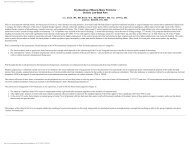A Proposed Clinical Reasoning Model For Western Acupuncture
A Proposed Clinical Reasoning Model For Western Acupuncture
A Proposed Clinical Reasoning Model For Western Acupuncture
Create successful ePaper yourself
Turn your PDF publications into a flip-book with our unique Google optimized e-Paper software.
MECHANISMS UNDERPINNING THE<br />
LAYERING METHOD<br />
In addition to knowledge of anatomy,<br />
acupuncture points, peripheral neuroanatomy and<br />
segmental innervation, the clinician could find an<br />
understanding of the following mechanisms useful.<br />
TISSUE MECHANISMS<br />
Tissue mechanisms concern the stage of injury<br />
or healing of the patient’s condition (Gifford & Butler,<br />
1997). These range from acute or chronic<br />
inflammation to collagen remodeling. Knowledge of<br />
the injury and healing process, and the time frame<br />
of these processes will allow the acupuncturist to<br />
implement the optimum treatment for that particular<br />
stage of healing. Treatment can be tailored to the<br />
state of the injury by increasing or decreasing blood<br />
flow via encouragement of peripheral effects and/or<br />
manipulation of the sympathetic nervous system<br />
(Carlson, 2002; Lundeberg, 1998).<br />
PAIN MECHANISMS<br />
There are several methods of classifying pain<br />
and the one used here is that of Gifford and Butler<br />
(1997). <strong>Acupuncture</strong> may be more or less effective<br />
for different pain types so diagnosis of the<br />
predominant pain mechanism should underpin<br />
treatment decisions and determination of prognosis<br />
(Lundeberg & Ekholm, 2001).<br />
Nociceptive Pain<br />
Nociceptive pain relies on an intact nervous system<br />
as it results from nociceptor stimulation in the<br />
peripheral tissues. This can be via mechanical,<br />
inflammatory or ischaemic mechanisms and is usually<br />
associated with acute pain and/or tissue injury.<br />
Peripheral nerve endings and dorsal horn neurons in<br />
the spinal cord become sensitised, but these processes<br />
are self-limiting and resolve once the tissue has healed<br />
(Woolf & Costigan, 1999). A predictable stimulusresponse<br />
relationship exists between pain provocation<br />
and pain experience (Gifford & Butler, 1997).<br />
Nociceptive pain has been demonstrated to respond<br />
positively in response to acupuncture treatment<br />
(Lundeberg, Hurtig, Lundeberg, & Thomas, 1988a).<br />
Neurogenic pain<br />
Neurogenic pain arises from a segment of nerve<br />
or the dorsal root ganglion due to axon damage<br />
(Myers, 1995). An atypical reaction to sensory inputs<br />
whereby non-noxious input will evoke or sustain pain<br />
results, hence neurogenic pain is characterised by<br />
allodynia and hyperalgesia (Wiesenfeld-Hallin & Zu,<br />
1996). In addition, synthesis of the neuropeptide<br />
cholecystokinin (CCK) increases following nerve<br />
injury. CCK is known to function as an endogenous<br />
opioid antagonist, therefore, the effect of the usual<br />
opioid pain inhibitory systems may be less effective<br />
(Wiesenfeld-Hallin & Zu, 1996). This suggests<br />
conventional acupuncture may not be useful for<br />
neurogenic pain. Preliminary information suggests<br />
that electroacupuncture applied with a high<br />
frequency/low intensity paradigm may activate the<br />
noradrenergic (non-opioid) pathways in the spinal<br />
cord (White, 1999). Scientific investigation however<br />
is required to support high frequency/low intensity<br />
electroacupuncture as an option for relief of<br />
neurogenic pain.<br />
Centrally-evoked Pain<br />
This pain mechanism is related to altered CNS<br />
circuitry and processing. <strong>For</strong> unknown and probably<br />
multi-faceted reasons there is prolonged sensitisation<br />
of the spinal cord and regions of the sensory cortex in<br />
the brain after the initial injury has healed. It becomes,<br />
therefore, a component of chronic pain syndrome<br />
(Coderre, Arroyo, & Champion, 1993). The features<br />
of this pain type include ongoing pain after the injury<br />
has healed that present as unfamiliar anatomic pain<br />
patterns with atypical and unpredictable pain<br />
behaviors. Patients may exhibit variable responses<br />
to treatment and a poor response to medication<br />
(Gifford & Butler, 1997). Sympathetic nervous system<br />
(SNS) contribution to inflammation via activation of<br />
the lateral sympathetic horn in the spinal cord or by<br />
a centrally mediated autonomic response may be a<br />
feature of this pain type (Coderre, Arroyo, & Champion,<br />
1993). The patient may exhibit sympathetic signs in<br />
related segments, including swelling and redness, but<br />
often there may be no signs. Slow healing<br />
musculoskeletal conditions might be related to<br />
inhibition of the SNS leading to trophic changes in<br />
target tissues (Bekkering & van Bussel, 1998).<br />
Lundeberg et al (2001) suggests acupuncture may be<br />
used in this pain mechanism, in particular in the early<br />
stages of chronicity when the level of dysfunction in<br />
the CNS is not known and some inhibitory pathways<br />
may be patent. These authors recommend decreasing<br />
sympathetic activity in the chronic pain patient by<br />
using a combination of warmth, gentle acupuncture<br />
or transcutaneous nerve stimulation with light<br />
stimulation only. According to Lundeberg & Elkholm<br />
(2001) ear acupuncture may also be used to increase<br />
parasympathetic activity. Lundeberg (1998) has also<br />
suggested that acupuncture may aid the chronic pain<br />
patient in terms of elevating mood and encouraging<br />
sleep. One investigation has been demonstrated that<br />
acupuncture releases neuro-chemicals in the brain a<br />
response that has the potential to affect the regulation<br />
of bodily processes, including both mood and sleep<br />
(Sjolund, Terenius & Eriksson, 1977).<br />
Somatic Nervous System Mechanisms<br />
Many acupuncture points are on or close to<br />
major peripheral nerve trunks. By needling these<br />
points, acupuncture may influence all tissues<br />
supplied by the nerve. As around 70% of<br />
acupuncture points lie in muscle tissue (Melzack,<br />
Stillwell, & Fox, 1977), the myotomal innervation<br />
of muscles should be learned and applied in<br />
practice. Alternatively, dermatomes and<br />
scleratomes can be chosen if the anatomical<br />
location of the acupuncture point is not in muscle<br />
tissue. Carlson (2002) proposes that the<br />
NZ Journal of Physiotherapy – March 2003. Vol. 31,1 41






